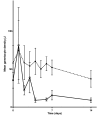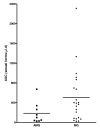Effects of mefloquine and artesunate mefloquine on the emergence, clearance and sex ratio of Plasmodium falciparum gametocytes in malarious children
- PMID: 20015395
- PMCID: PMC2805687
- DOI: 10.1186/1475-2875-8-297
Effects of mefloquine and artesunate mefloquine on the emergence, clearance and sex ratio of Plasmodium falciparum gametocytes in malarious children
Abstract
Background: The gametocyte sex ratio of Plasmodium falciparum, defined as the proportion of gametocytes that are male, may influence transmission but little is known of the effects of mefloquine or artesunate-mefloquine on gametocyte sex ratio and on the sex ratio of first appearing gametocytes.
Methods: 350 children with uncomplicated P. falciparum malaria were enrolled in prospective treatment trial of mefloquine or artesunate-mefloquine between 2007 and 2008. Gametocytaemia was quantified, and gametocytes were sexed by morphological appearance, before and following treatment. The area under curve of gametocyte density versus time (AUCgm) was calculated by linear trapezoidal method.
Results: 91% and 96% of all gametocytes appeared by day 7 and day 14, respectively following treatment. The overall rate of gametocytaemia with both treatments was 31%, and was significantly higher in mefloquine than in artesunate-mefloquine treated children if no gametocyte was present a day after treatment began (25.3% v 12.8%, P = 0.01). Gametocyte clearance was significantly faster with artesunate-mefloquine (1.8 +/- 0.22 [sem] v 5.6 +/- 0.95 d; P = 0.001). AUCgm was significantly lower in the artesunate mefloquine group (P = 0.008). The pre-treatment sex ratio was male-biased, but post-treatment sex ratio or the sex ratio of first appearing gametocytes, was significantly lower and female-biased two or three days after beginning of treatment in children given artesunate-mefloquine.
Conclusion: Addition of artesunate to mefloquine significantly modified the emergence, clearance, and densities of gametocytes and has short-lived, but significant, sex ratio modifying effects in children from this endemic area.
Figures





References
-
- Hogh B, Gamage-Mendis A, Butcher GA, Thompson R, Begtrup K, Mendis C, Enosse SM, Dgedge M, Barreto J, Eling W, Sinden RE. The differing impact of chloroquine and pyrimethamine/sulfadoxine upon the infectivity of malaria species to its vector. Am J Trop Med Hyg. 1998;58:176–182. - PubMed
-
- Ross A, Killeen G, Smith T. Relationships between host infectivity to mosquitoes and asexual parasite density in Plasmodium falciparum . Am J Trop Med Hyg. 2006;75(suppl 2):32–37. - PubMed
-
- Eichner M, Diebner HH, Molineaux L, Collins WE, Jeffery GM, Dietz K. Genesis, sequestration and survival of Plasmodium falciparum gametocytes: parameter estimates from fitting a model to malariotherapy data. Trans R Soc Trop Med Hyg. 2001;95:297–501. doi: 10.1016/S0035-9203(01)90016-1. - DOI - PubMed
MeSH terms
Substances
LinkOut - more resources
Full Text Sources
Medical

